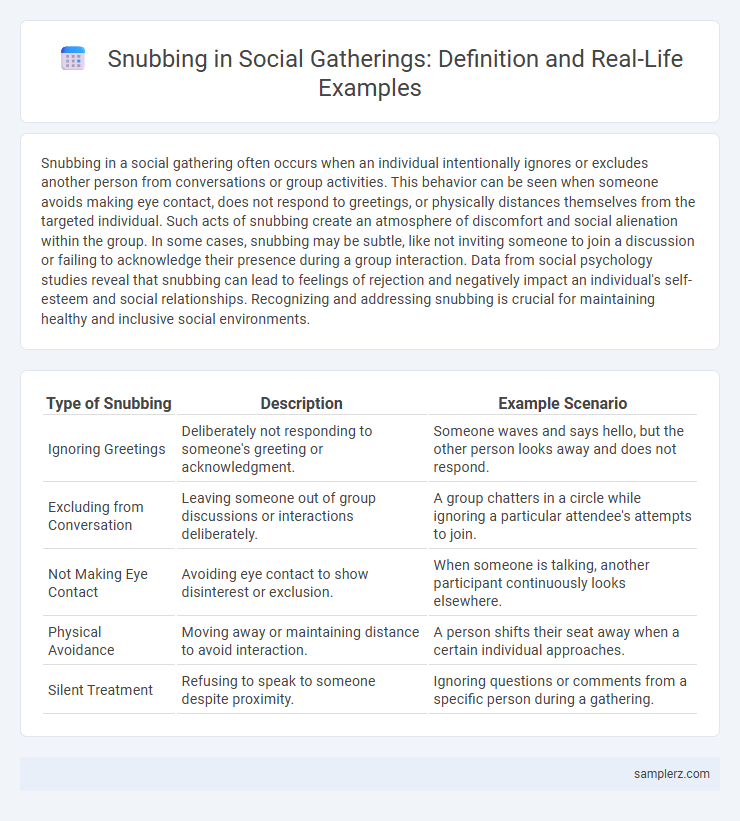Snubbing in a social gathering often occurs when an individual intentionally ignores or excludes another person from conversations or group activities. This behavior can be seen when someone avoids making eye contact, does not respond to greetings, or physically distances themselves from the targeted individual. Such acts of snubbing create an atmosphere of discomfort and social alienation within the group. In some cases, snubbing may be subtle, like not inviting someone to join a discussion or failing to acknowledge their presence during a group interaction. Data from social psychology studies reveal that snubbing can lead to feelings of rejection and negatively impact an individual's self-esteem and social relationships. Recognizing and addressing snubbing is crucial for maintaining healthy and inclusive social environments.
Table of Comparison
| Type of Snubbing | Description | Example Scenario |
|---|---|---|
| Ignoring Greetings | Deliberately not responding to someone's greeting or acknowledgment. | Someone waves and says hello, but the other person looks away and does not respond. |
| Excluding from Conversation | Leaving someone out of group discussions or interactions deliberately. | A group chatters in a circle while ignoring a particular attendee's attempts to join. |
| Not Making Eye Contact | Avoiding eye contact to show disinterest or exclusion. | When someone is talking, another participant continuously looks elsewhere. |
| Physical Avoidance | Moving away or maintaining distance to avoid interaction. | A person shifts their seat away when a certain individual approaches. |
| Silent Treatment | Refusing to speak to someone despite proximity. | Ignoring questions or comments from a specific person during a gathering. |
Subtle Snubbing: Ignoring Someone’s Input
In social gatherings, subtle snubbing often manifests as deliberately ignoring someone's contributions during conversations, undermining their presence without overt rudeness. This form of exclusion can occur when a person's suggestions or opinions are consistently overlooked, causing feelings of invisibility and frustration. Such behavior not only damages interpersonal relationships but also deteriorates group dynamics and inclusivity.
Social Exclusion: Leaving Someone Out of Conversations
Social exclusion occurs when individuals deliberately ignore or exclude someone from conversations during gatherings, creating feelings of isolation and rejection. This behavior often manifests through subtle actions such as avoiding eye contact, not addressing the person, or deliberately changing topics to exclude their interests. Consistent social snubbing not only damages self-esteem but can also lead to long-term emotional distress and weakened social bonds.
The Cold Shoulder: Deliberate Non-Engagement in Groups
The cold shoulder in social gatherings manifests as deliberate non-engagement, where an individual intentionally avoids eye contact, conversation, or acknowledgment from group members. This behavior signals exclusion and can lead to feelings of isolation and social rejection within the collective. Studies show that such snubbing disrupts group cohesion and negatively impacts emotional well-being.
Body Language Snubs: Turning Away During Talks
Turning away or avoiding eye contact while someone is speaking at a social gathering signals disinterest and disrespect, undermining effective communication. Crossed arms, looking at a phone, or shifting posture away from the speaker further reinforce exclusion and social snubbing. These body language cues create discomfort and can damage relationships by conveying rejection without words.
Selective Invitation: Overlooking Certain People
Selective invitation in social gatherings often results in snubbing by deliberately excluding specific individuals based on personal biases or social status. This exclusion can lead to feelings of isolation and damage relationships, as the overlooked guests perceive the act as a direct affront. Such behavior disrupts group dynamics and fosters resentment among those disregarded.
Phone Snubbing (Phubbing) at Social Events
Phone snubbing, or phubbing, disrupts social gatherings by diverting attention from face-to-face interactions to mobile devices, diminishing the quality of communication. Studies show that phubbing increases feelings of social exclusion and lowers satisfaction during social events. Addressing phone snubbing enhances engagement and fosters stronger personal connections in group settings.
Inside Jokes: Excluding Outsiders in Gatherings
Inside jokes in social gatherings often create an exclusive atmosphere that unintentionally snubs outsiders, making them feel alienated and unwelcome. These private references strengthen bonds among insiders but can highlight differences, causing discomfort for those unfamiliar with the humor. Such exclusionary dynamics adversely impact group cohesion and hinder inclusive social interactions.
Favoritism: Giving Undue Attention to a Few
Favoritism in social gatherings manifests when hosts or group leaders disproportionately engage with select individuals, sidelining others and disrupting group cohesion. This undue attention often leads to visible exclusion, causing discomfort and resentment among overlooked guests. Studies indicate that perceived favoritism can significantly reduce overall group satisfaction and increase social anxiety for those ignored.
Public Criticism: Embarrassing Others to Isolate Them
At social gatherings, public criticism serves as a potent form of snubbing by openly embarrassing individuals to isolate them from the group. This behavior often involves highlighting personal flaws or mistakes in front of others, creating social discomfort and alienation. Such actions undermine social cohesion and foster exclusion, reinforcing the snubber's dominance within the group dynamic.
Withholding Greetings: Purposely Not Acknowledging Presence
Withholding greetings at social gatherings often signals intentional exclusion or disrespect, as individuals purposefully avoid acknowledging someone's presence. This form of snubbing can create feelings of isolation and tension, disrupting group dynamics and diminishing the sense of inclusivity. Recognizing such behavior is crucial for fostering respectful communication and maintaining healthy social interactions.

example of snubbing in gathering Infographic
 samplerz.com
samplerz.com